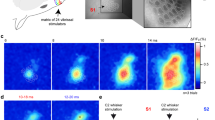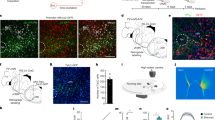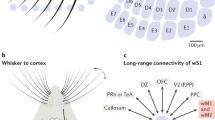Abstract
The rodent vibrissa system is a widely used experimental model of active sensation and motor control. Vibrissa-based touch in rodents involves stereotypic, rhythmic sweeping of the vibrissae as the animal explores its environment. Although pharmacologically induced rhythmic movements have long been used to understand the neural circuitry that underlies a variety of rhythmic behaviors, including locomotion, digestion and ingestion, these techniques have not been available for active sensory movements such as whisking. However, recent work that delineated the location of the central pattern generator for whisking has enabled pharmacological control over this behavior. Here we specify a protocol for the pharmacological induction of rhythmic vibrissa movements that mimic exploratory whisking. The rhythmic vibrissa movements are induced by local injection of a glutamatergic agonist, kainic acid. This protocol produces coordinated rhythmic vibrissa movements that are sustained for several hours in the anesthetized mouse or rat and thus provides unprecedented experimental control in studies related to vibrissa-based neuronal circuitry.
This is a preview of subscription content, access via your institution
Access options
Subscribe to this journal
Receive 12 print issues and online access
$259.00 per year
only $21.58 per issue
Buy this article
- Purchase on Springer Link
- Instant access to full article PDF
Prices may be subject to local taxes which are calculated during checkout







Similar content being viewed by others
References
Cullen, K.E. Sensory signals during active versus passive movement. Curr. Opin. Neurobiol. 14, 698–706 (2004).
von Holst, E. Relations between the central nervous system and the peripheral organ. Br. J. Animal Behav. 2, 89–94 (1954).
Vincent, S.B. The tactile hair of the white rat. J. Comp. Neurol. 23, 1–23 (1913).
Rice, F.L., Fundin, B.T., Arvidsson, J., Aldskogius, H. & Johansson, O. Comprehensive immunofluoresce and lectin binding study of the innervation of vibrissae follicle sinus complexes on the mystacial pad of the rat. J. Comp. Neurol. 385, 149–184 (1997).
Prescott, T.J., Diamond, M.E. & Wing, A.M. Active touch sensing. Philos. Trans. R Soc. Lond. B Biol. Sci. 366, 2989–2995 (2011).
Kleinfeld, D. & Deschênes, M. Neuronal basis for object location in the vibrissa scanning sensorimotor system. Neuron 72, 455–468 (2011).
Mitchinson, B. et al. Active vibrissal sensing in rodents and marsupials. Phil. Trans. R Soc. Lond. B Biol. Sci. 366, 3037–3048 (2011).
Bosman, L.W.J. et al. Anatomical pathways involved in generating and sensing rhythmic whisker movements. Front. Integr. Neurosci. 5, 1 (2011).
Kleinfeld, D., Ahissar, E. & Diamond, M.E. Active sensation: insights from the rodent vibrissa sensorimotor system. Curr. Opin. Neurobiol. 16, 435–444 (2006).
Brecht, M. Barrel cortex and whisker-mediated behaviors. Curr. Opin. Neurobiol. 17, 408–416 (2007).
Hill, D.N., Curtis, J.C., Moore, J.D. & Kleinfeld, D. Primary motor cortex reports efferent control of vibrissa position on multiple time scales. Neuron 72, 344–356 (2011).
Berg, R.W. & Kleinfeld, D. Rhythmic whisking by rat: retraction as well as protraction of the vibrissae is under active muscular control. J. Neurophysiol. 89, 104–117 (2003).
Moore, J.D. et al. Hierarchy of orofacial rhythms revealed through whisking and breathing. Nature 469, 53–57 (2013).
Matyas, F. et al. Motor control by sensory cortex. Science 330, 1240–1243 (2010).
Brecht, M., Schneider, M., Sakmann, B. & Margrie, T. Whisker movements evoked by stimulation of single pyramidal cells in rat motor cortex. Nature 427, 704–710 (2004).
Mao, T. et al. Long-range neuronal circuits underlying the interaction between sensory and motor cortex. Neuron 72, 111–123 (2011).
Guo, Z.V. et al. Flow of cortical activity underlying a tactile decision in mice. Neuron 81, 179–194 (2014).
Nguyen, Q.-T. & Kleinfeld, D. Positive feedback in a brainstem tactile sensorimotor loop. Neuron 45, 447–457 (2005).
Curtis, J.C. & Kleinfeld, D. Phase-to-rate transformations encode touch in cortical neurons of a scanning sensorimotor system. Nat. Neurosci. 12, 492–501 (2009).
O'Connor, D.H., Peron, S.P., Huber, D. & Svoboda, K. Neural activity in barrel cortex underlying vibrissa-based object localization in mice. Neuron 67, 1048–1061 (2010).
O'Connor, D.H. et al. Neural coding during active somatosensation revealed using illusory touch. Nat. Neurosci. 16, 958–965 (2013).
Gentet, L.J., Avermann, M., Matyas, F., Staiger, J.F. & Petersen, C.C.H. Membrane potential dynamics of GABAergic neurons in the barrel cortex of behaving mice. Neuron 65, 422–435 (2010).
Crochet, S. & Petersen, C.C.H. Correlating membrane potential with behaviour using whole-cell recordings from barrel cortex of awake mice. Nat. Neurosci. 9, 608–609 (2006).
Fee, M.S., Mitra, P.P. & Kleinfeld, D. Central versus peripheral determinates of patterned spike activity in rat vibrissa cortex during whisking. J. Neurophysiol. 78, 1144–1149 (1997).
Marder, E. & Calabrese, R.L. Principles of rhythmic motor pattern generation. Physiol. Rev. 76, 687–717 (1996).
Getting, P.A. Emerging principles governing the operation of neural networks. Annu. Rev. Neurosci. 12, 185–204 (1989).
Grillner, S., McClellan, A., Sigvardt, K., Wallen, P. & Wilen, M.A. Activation of NMDA-receptors elicits 'fictive locomotion' in lamprey spinal cord in vitro. Acta Physiol. Scand. 113, 549–551 (1981).
Rossignol, S. & Dubuc, R. Spinal pattern generation. Curr. Opin. Neurobiol. 4, 894–902 (1994).
Yamaguchi, T. The central pattern generator for forelimb locomotion in the cat. Prog. Brain Res. 143, 114–122 (2004).
McCrea, D.A. Spinal circuitry of sensorimotor control of locomotion. J. Physiol. 533, 41–50 (2001).
Cazalets, J., Sqalli-Houssaini, Y. & Clarac, F. Activation of the central pattern generators for locomotion by serotonin and excitatory amino acids in neonatal rat. J. Physiol. 455, 187–204 (1992).
Stein, P.S., McCullough, M.L. & Currie, S.N. Spinal motor patterns in the turtle Ann. N Y Acad. Sci. 860, 142–154 (1998).
Nakamura, Y., Katakura, N. & Nakajima, M. Generation of rhythmical ingestive activities of the trigeminal, facial, and hypoglossal motoneurons in in vitro CNS preparations isolated from rats and mice. J. Med. Dent. Sci. 46, 63–73 (1999).
Zucker, E. & Welker, W.I. Coding of somatic sensory input by vibrissae neurons in the rat's trigeminal ganglion. Brain Res. 12, 134–156 (1969).
Brown, A.W.S. & Waite, P.M.E. Responses in the rat thalamus to whisker movements produced by motor nerve stimulation. J. Physiol. 238, 387–401 (1974).
Szwed, M., Bagdasarian, K. & Ahissar, E. Coding of vibrissal active touch. Neuron 40, 621–630 (2003).
Yu, C., Derdikman, D., Haidarliu, S. & Ahissar, E. Parallel thalamic pathways for whisking and touch signals in the rat. PLoS Biol. 4, e124 (2006).
Henneman, E. The size-principle: a deterministic output emerges from a set of probabilistic connections. J. Exp. Biol. 115, 105–112 (1985).
Llewellyn, M.E., Thompson, K.R., Deisseroth, K. & Delp, S.L. Orderly recruitment of motor units under optical control in vivo. Nat. Med. 16, 1161–1165 (2010).
Kilkenny, C., Browne, W., Cuthill, I.C., Emerson, M. & Altman, D.G. Animal research: reporting in vivo experiments: the ARRIVE guidelines. Br. J. Pharmacol. 160, 1577–1579 (2010).
Kilkenny, C., Browne, W.J., Cuthill, I.C., Emerson, M. & Altman, D.G. Improving bioscience research reporting: The ARRIVE guidelines for reporting animal research. PLoS Biol. 8, e1000412 (2010).
Dirnagl, U. & Lauritzen, M. Improving the quality of biomedical research: guidelines for reporting experiments involving animals. J. Cereb. Blood Flow Metab. 31, 989–990 (2012).
Gao, P., Hattox, A.M., Jones, L.M., Keller, A. & Zeigler, H.P. Whisker motor cortex ablation and whisker movement patterns. Somatosens. Mot. Res. 20, 191–198 (2003).
Hadlock, T.A., Kowaleski, J., Lo, D., Mackinnon, S.E. & Heaton, J.T. Rodent facial nerve recovery after selected lesions and repair techniques. Plast. Reconstr. Surg. 125, 99–109 (2010).
Jongen-Rêlo, A.L. & Feldon, J. Specific neuronal protein: a new tool for histological evaluation of excitotoxic lesions. Physiol. Behav. 76, 449–456 (2002).
Lavallee, P. et al. Feedforward inhibitory control of sensory information in higher-order thalamic nuclei. J. Neurosci. 25, 7489–7498 (2005).
Welker, W.I. Analysis of sniffing of the albino rat. Behaviour 12, 223–244 (1964).
Towal, R.B. & Hartmann, M.J. Variability in velocity profiles during free-air whisking behavior of unrestrained rats. J. Neurophysiol. 100, 740–752 (2008).
Hill, D.N., Bermejo, R., Zeigler, H.P. & Kleinfeld, D. Biomechanics of the vibrissa motor plant in rat: rhythmic whisking consists of triphasic neuromuscular activity. J. Neurosci. 28, 3438–3455 (2008).
Khatri, V., Bermejo, R., Brumberg, J.C. & Zeigler, H.P. Whisking in air: encoding of kinematics by VPM neurons in awake rats. Somatosens. Mot. Res. 27, 11–20 (2010).
Khatri, V., Bermejo, R., Brumberg, J.C., Keller, A. & Zeigler, H.P. Whisking in air: encoding of kinematics by trigeminal ganglion neurons in awake rats. J. Neurophysiol. 101, 836–886 (2009).
Hellon, R. The marking of electrode tip positions in nervous tissue. J. Physiol. 214, 12O (1971).
Klein, B. & Rhoades, R. The representation of whisker follicle intrinsic musculature in the facial motor nucleus of the rat. J. Comp. Neurol. 232, 55–69 (1985).
Mitchinson, B., Martin, C.J., Grant, R.A. & Prescott, T.J. Feedback control in active sensing: rat exploratory whisking is modulated by environmental contact. Proc. R Soc. Lond. Biol. Sci. 274, 1035–1041 (2007).
Towal, R.B. & Hartmann, M.J. Right-left asymmetries in the whisking behavior of rats anticipate movements. J. Neurosci. 26, 8838–8846 (2006).
Hattox, A.M., Li, Y. & Keller, A. Serotonin regulates rhythmic whisking. Neuron 39, 343–352 (2003).
van der Maelen, C. & Aghajanian, G. Intracellular studies showing modulation of facial motoneurone excitability by serotonin. Synapse 3, 331–338 (1980).
Harish, O. & Golomb, D. Control of the firing patterns of vibrissa motoneurons by modulatory and phasic synaptic inputs: a modeling study. J. Neurophysiol. 103, 2684–2699 (2010).
Pietr, M.D., Knutsen, P.M., Shore, D.I., Ahissar, E. & Vogel, Z. Cannabinoids reveal separate controls for whisking amplitude and timing in rats. J. Neurophysiol. 104, 2532–2542 (2010).
Wu, A.P. et al. Improved facial nerve identification with novel fluorescently labeled probe. Laryngoscope 121, 805–810 (2011).
Berens, P. CircStat: A MATLAB toolbox for circular statistics. J. Statist. Software 31, 1–21 (2009).
Batschelet, E. Circular Statistics in Biology (Academic Press, 1981).
Wong-Riley, M.T.T. Endogenous peroxidatic activity in brain stem neurons as demonstrated by their staining with diaminobenzidine in normal squirrel monkeys. Brain Res. 108, 257–277 (1976).
Acknowledgements
This work was supported by grants from the National Institute of Neurological Disorders and Stroke (NS058668 and NS082097), the National Institute of Biomedical Imaging and Bioengineering (EB003832), the Canadian Institutes of Health Research (grant MT-5877) and the US-Israeli Binational Foundation (grant 2011432).
Author information
Authors and Affiliations
Contributions
M.D., D.K. and J.D.M. planned the experiments; M.D., A.K. and J.D.M. performed the experiments; A.K. and J.D.M. analyzed the data; D.K. and J.D.M. wrote the paper; D.K. dealt with the myriad university organizations that govern animal health and welfare, surgical procedures, and laboratory health and safety issues that include specific oversight of chemicals, controlled substances, human cell lines, lasers and viruses.
Corresponding author
Ethics declarations
Competing interests
The authors declare no competing financial interests.
Rights and permissions
About this article
Cite this article
Moore, J., Deschênes, M., Kurnikova, A. et al. Activation and measurement of free whisking in the lightly anesthetized rodent. Nat Protoc 9, 1792–1802 (2014). https://doi.org/10.1038/nprot.2014.119
Published:
Issue Date:
DOI: https://doi.org/10.1038/nprot.2014.119
This article is cited by
-
The whisking oscillator circuit
Nature (2022)
Comments
By submitting a comment you agree to abide by our Terms and Community Guidelines. If you find something abusive or that does not comply with our terms or guidelines please flag it as inappropriate.



